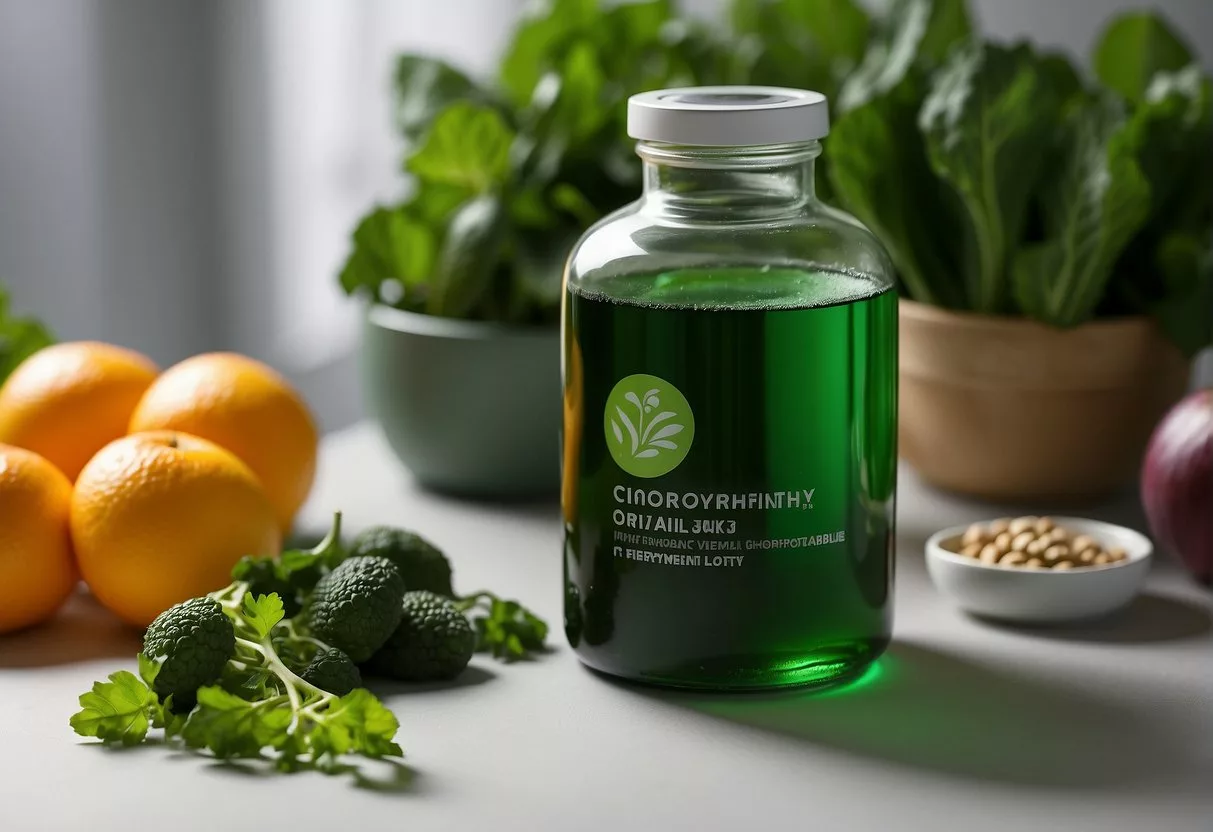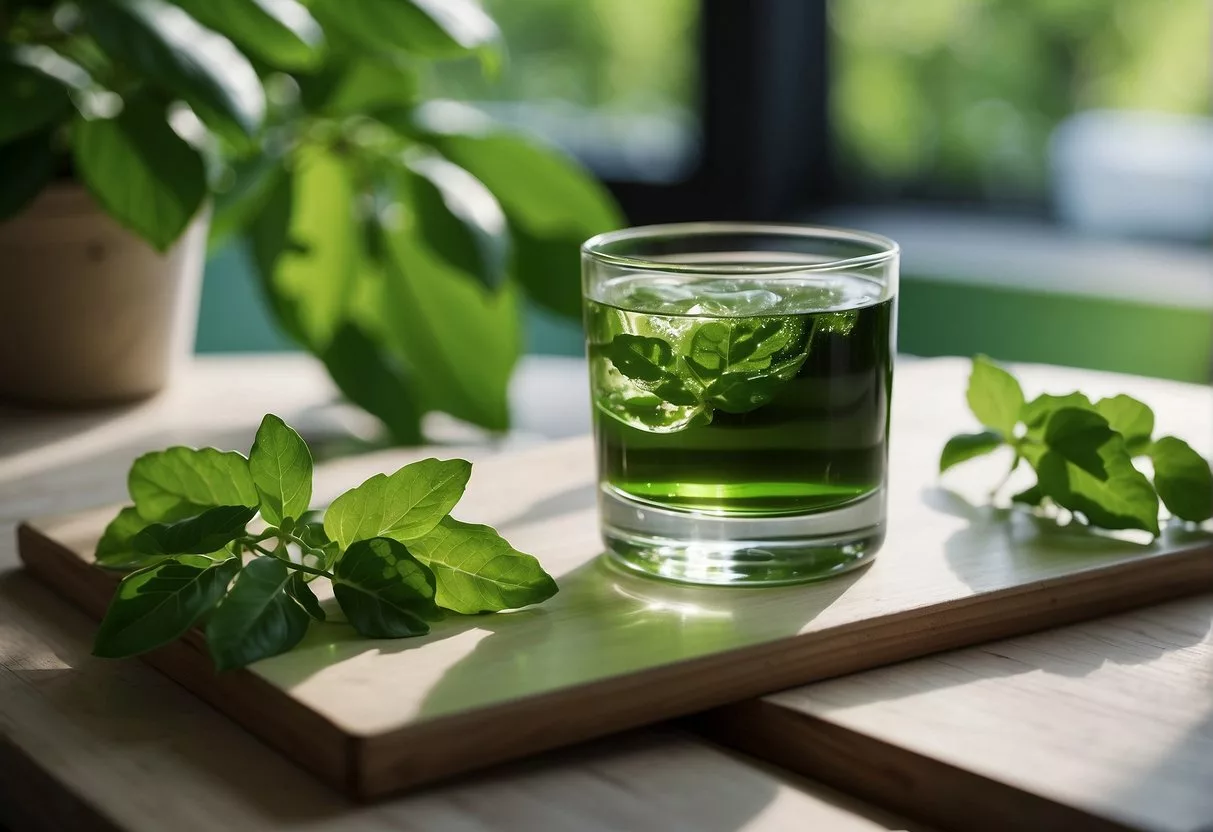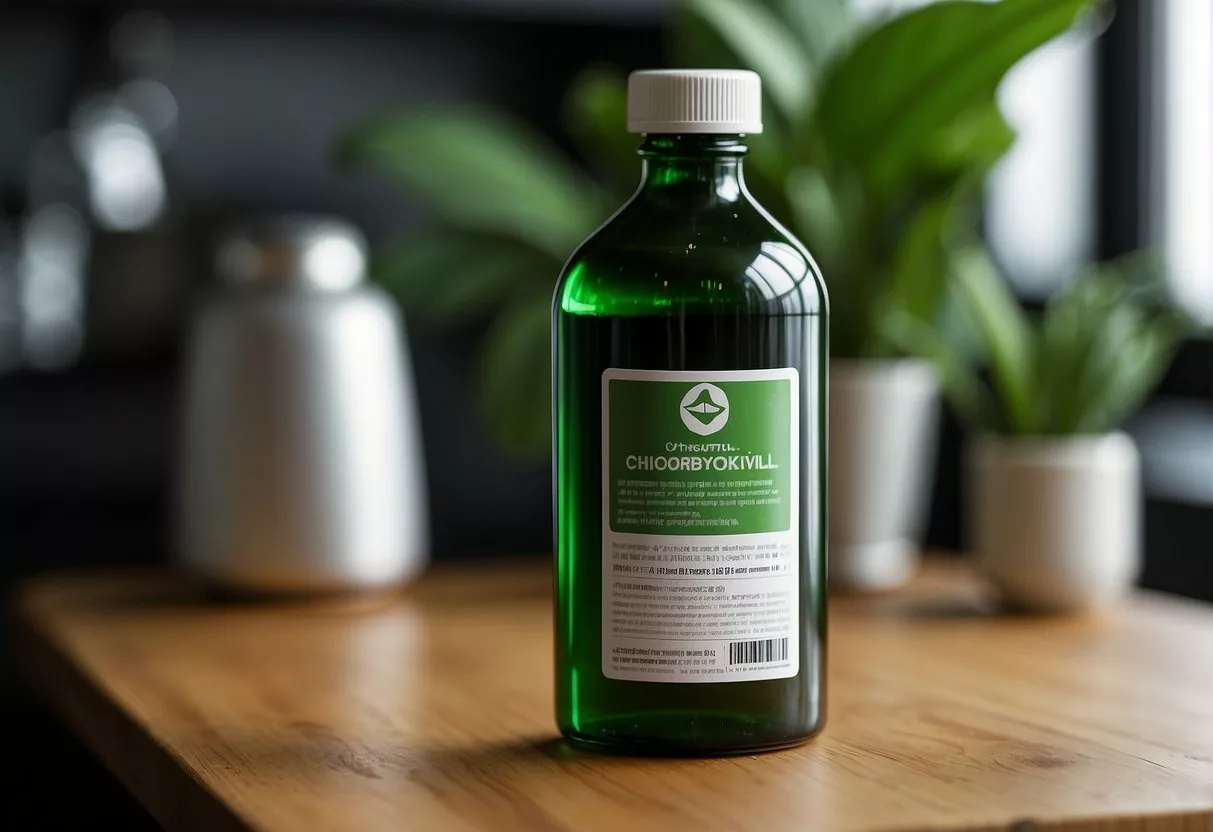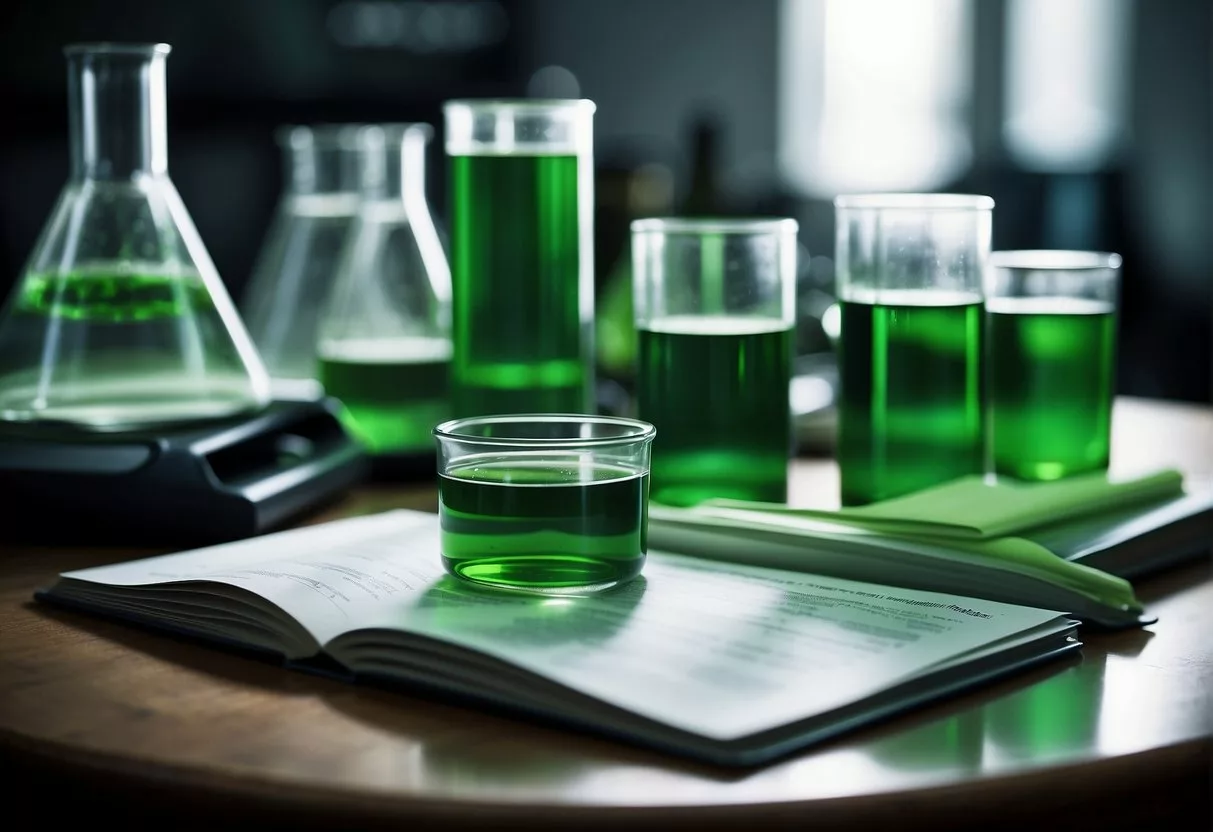Liquid chlorophyll is a supplement that has gained attention for its potential health benefits, reminiscent of the pivotal role chlorophyll plays in plants.
In nature, chlorophyll is the green pigment crucial for photosynthesis, the process by which plants absorb energy from sunlight. It is essential for plants to produce the oxygen and glucose necessary for life on Earth.
As a supplement, liquid chlorophyll is consumed for its assumed health advantages, which mimic some of the effects chlorophyll has in the plant kingdom.

Human interest in liquid chlorophyll stems from the substance’s purported antioxidant properties and its role in promoting wellness. Advocates suggest that it can improve skin health, assist in detoxification, and support energy levels.
The supplement is believed to have deodorizing effects as well, and some studies have proposed that it might aid in wound healing and weight management.
However, scientific research on liquid chlorophyll is limited, and much of the evidence for these benefits is anecdotal or based on preliminary studies.
Despite its growing popularity, consuming liquid chlorophyll also carries potential risks. It’s important to be aware of the proper dosage, as well as the possible side effects, such as digestive disturbances.
Individuals considering liquid chlorophyll should consult with healthcare professionals, particularly because supplements are not as tightly regulated as pharmaceuticals and may interact with other medications or underlying health conditions.
Transparency about its effects, both beneficial and adverse, is essential for informed consumption.
What is Chlorophyll?

Chlorophyll is a crucial pigment that gives plants their characteristic green color. It plays an essential role in photosynthesis, the process by which plants use sunlight to create energy.
The Role of Chlorophyll in Plants
Chlorophyll is located in the chloroplasts of plant cells where it absorbs sunlight. This absorbed light is then converted into chemical energy through the process of photosynthesis.
It enables plants to create nutrients from carbon dioxide and water, essentially using sunlight as the energy source.
Chlorophyllin vs. Natural Chlorophyll
Natural chlorophyll is the pigment directly involved in photosynthesis. It is a complex molecule found in plants and is not water-soluble, making it difficult for humans to absorb when consumed through diet.
On the other hand, chlorophyllin is a water-soluble derivative of chlorophyll. It is readily absorbable when consumed and is commonly found in supplements and products claiming to offer the benefits of chlorophyll.
Health Benefits of Liquid Chlorophyll

Liquid chlorophyll, often derived from green vegetables and leafy greens, has garnered attention for its potential health benefits, which revolve around its antioxidant properties and its purported ability to support overall well-being.
Antioxidant Effects
Chlorophyll is noted for its antioxidant properties, which may help in reducing oxidative stress in the body. Oxidative stress is linked with various chronic diseases, and chlorophyll’s antioxidant effects could potentially play a role in the body’s defense system.
Cancer Prevention and Treatment
One of the more researched areas of chlorophyll’s benefits is its role in cancer prevention and treatment. Though research is ongoing, some studies indicate that chlorophyll may bind with potential carcinogens and interfere with how they are absorbed within the human gastrointestinal tract.
Skin Health and Healing
For conditions such as acne or other skin problems, chlorophyll can contribute positively to skin health and healing. Compounds in chlorophyll may improve the quality of the skin and have been used in topical treatments to aid in healing and reducing inflammation.
Weight Management and Digestion
Liquid chlorophyll can assist in weight management and digestion. It’s believed that chlorophyll can help to promote the feeling of fullness and support healthy digestion, thanks in part to the presence of fiber in many chlorophyll-rich supplements.
Energy Boost and Detoxification
Many users turn to chlorophyll for an energy boost and detoxification. The compound is thought to stimulate red blood cell production, enhancing energy levels. Additionally, it’s often credited with detoxification properties, aiding in the elimination of toxins from the body.
Immune System Support
By providing essential vitamins and nutrients found in wheatgrass, spirulina, and other chlorophyll-rich sources, liquid chlorophyll can be supportive of the immune system. It may contribute to creating an environment within the body that promotes overall health and disease resistance.
Nutritional Profile of Chlorophyll Supplements

Chlorophyll supplements offer a concentrated way to ingest this green pigment, which is reputed for its potential health benefits. These products typically come in various forms such as powders, tablets, drops, and more.
Sources and Forms of Supplements
Chlorophyll supplements are derived from green plants such as spinach, parsley, arugula, kale, and broccoli. They are available in several forms:
- Powder: Can be mixed with water or added to smoothies.
- Tablets/Pills: Offer a convenient way to ingest chlorophyll without taste.
- Drops: Liquid form that can be added to water or other beverages.
- Ointments: Typically used for topical application and not for ingestion.
These supplements provide a more concentrated dose of chlorophyll compared to whole food sources, which can be beneficial for individuals seeking specific therapeutic effects.
Comparison with Whole Food Sources
Whole food sources of chlorophyll come from a diet rich in green vegetables, such as spinach, arugula, and kale. Whole foods provide a complex matrix of nutrients, including fiber, vitamins, and minerals that supplements may not offer. For example:
- Spinach contains additional nutrients like vitamin K, vitamin A, and iron.
- Parsley is rich in vitamin C and other healthful compounds like flavonoids.
Chlorophyll supplements, while convenient, often lack the full spectrum of nutrients that these whole foods offer. Conversely, supplements can be favorable for those requiring higher doses of chlorophyll that may be impractical to obtain solely through diet.
Usage and Dosage Recommendations

When considering liquid chlorophyll supplements, it is imperative to adhere to recommended dosage guidelines and take into account specific needs of different populations. Following these recommendations can help ensure safe and effective use.
Recommended Dosage for Adults
The typical dose for adults consuming liquid chlorophyll is between 100 milligrams and 300 milligrams per day. This can be taken once or divided into several doses throughout the day, depending on the product’s concentration and the advice of a healthcare provider.
It is advisable for individuals to consult with a registered dietitian or a healthcare professional to determine the appropriate dosage for their specific health needs.
Considerations for Special Populations
- Pregnant Women: It is crucial for pregnant women to consult their healthcare provider before taking liquid chlorophyll supplements. The safety of chlorophyllin at any dose during pregnancy has not been established.
- Breastfeeding: Similarly, those who are breastfeeding should seek medical advice prior to use, as there is insufficient data on the excretion of chlorophyll derivatives into breast milk.
- Medication Interactions: Individuals on any medications should discuss with their healthcare provider about possible interactions since chlorophyll can affect drug metabolism.
The use of liquid chlorophyll should be individualized and monitored by a professional, especially in populations with unique nutritional and health considerations.
Potential Side Effects and Risks

While liquid chlorophyll is generally considered safe for consumption, some individuals may experience side effects or encounter risks associated with its use. It’s important for readers to be aware of the common adverse reactions, how liquid chlorophyll can interact with certain medications, and considerations for its long-term use.
Common Adverse Reactions
Some individuals report experiencing stomach cramps, diarrhea, nausea, and vomiting after ingesting liquid chlorophyll. These side effects are often temporary but can be discomforting.
While not inherently toxic, it’s crucial to monitor the body’s response to liquid chlorophyll, especially when consumed in large quantities.
- Diarrhea and stomach cramps: May occur as a digestive response, particularly if liquid chlorophyll is taken on an empty stomach.
- Nausea and vomiting: Can result from an adverse reaction, emphasizing the importance of assessing the body’s tolerance.
Interaction with Medications
Liquid chlorophyll may interact with various medications, altering their effectiveness or increasing the risk of toxicity. People taking drugs that increase photosensitivity should be cautious, as chlorophyll may exacerbate this effect.
- Increases in copper levels: Caution is advised for individuals on copper-related medications.
- Interference with sodium balance: Individuals on sodium-related treatments should consult with a healthcare provider before use.
Considerations for Long-Term Use
Despite the lack of comprehensive studies on the long-term use of liquid chlorophyll, safety is a paramount concern. There are suggestions that excessive consumption could carry risks, such as a possible association with liver cancer, but evidence is not conclusive.
- Prolonged exposure and high doses: It’s suggested to consider the potential buildup of toxic elements over time.
- Safety in long-term use: Due diligence and moderation are advised when choosing to integrate liquid chlorophyll into regular dietary habits.
Research and Evidential Support

The efficacy and safety of liquid chlorophyll are topics of ongoing research. Studies aim to elucidate its benefits and risks in both humans and animals, as well as its potential role in cancer prevention and as a detoxifying agent.
Studies in Humans and Animals
Research has included studies on both human and animal subjects to determine the bioactivity of chlorophyll. In humans, clinical trials have tested the potential for liquid chlorophyll to improve conditions such as skin damage caused by sun exposure.
Results from these studies have noted that topical chlorophyll may aid in improving sun-damaged skin over a period of 8 weeks.
Meanwhile, animal studies, particularly with mice, have provided a foundational understanding of how chlorophyll might affect various biological processes.
Research Findings on Specific Health Outcomes
Cancer Prevention: Some studies have suggested that chlorophyll might carry anticancer properties. They propose that its antioxidant capabilities could play a role in neutralizing cancer-promoting molecules. However, human trials to substantiate these effects, especially regarding pancreatic cancer cells, are not yet conclusive.
Detoxification: Research into the effects of chlorophyll on aflatoxin—a substance known to cause liver damage and cancer—has indicated that chlorophyll may reduce the bioavailability of this toxin, potentially helping in detox processes.
Medications and Safety: The interactions between liquid chlorophyll and various medications have not been thoroughly researched. Safety profiles require more robust data to ensure that liquid chlorophyll can be recommended without significant risk of adverse side effects.
Inflammation: Studies have also posited that chlorophyll may exhibit anti-inflammatory properties. However, the specific mechanisms and the extent of efficacy are subjects that call for further investigation.
Social Perception and Popular Usage

Liquid chlorophyll has become a trend largely due to its visibility on social media, where it is promoted for various health benefits and uses. Its popularity is driven by user testimonials and varying brand endorsements.
Influence of Social Media on Chlorophyll Popularity
The meteoric rise in the popularity of liquid chlorophyll can be attributed to social media platforms, where influencers and health enthusiasts tout its potential benefits. These platforms have facilitated a widespread belief that topical chlorophyll can improve skin health, particularly in addressing sun-damaged skin.
Moreover, liquid chlorophyll is often promoted as an all-natural deodorant solution, claiming to combat body odor with its purported internal deodorizing properties.
Consumer Testimonials and Anecdotal Reports
Consumer testimonials often highlight personal experiences and anecdotal evidence of the efficacy of liquid chlorophyll supplements. Brands may feature these testimonials to support claims regarding the holistic benefits of their products.
For example, the use of topical chlorophyll products is frequently backed by reports of individuals experiencing improved skin conditions over a course of treatment. Despite the prevalence of such claims, it is important to note that robust scientific backing is necessary to substantiate these benefits.
Frequently Asked Questions

What does drinking liquid chlorophyll do? Drinking liquid chlorophyll is thought to promote health benefits such as detoxification and higher energy levels. However, the claims about these benefits need more scientific backing.
What does liquid chlorophyll do for your stomach? Liquid chlorophyll can potentially ease digestion and constipation, but taking it on an empty stomach may cause discomfort, similar to taking iron.
Who should not take liquid chlorophyll? Individuals who have a sensitivity or allergy to chlorophyll, as well as those with kidney or liver issues, should avoid taking chlorophyll.
How does chlorophyll detox the body? Chlorophyll is believed to bind with toxins and might aid in the detoxification process, though concrete evidence for how it does this is limited.
Does chlorophyll help you lose belly fat? There is no substantial evidence that chlorophyll aids in targeted belly fat loss.
Is it OK to take chlorophyll every day? Generally, it is safe for healthy individuals to take chlorophyll daily in recommended amounts.
What can you not mix with chlorophyll? Chlorophyll should not be mixed with medications without consulting a doctor, as it may cause reactions.
Does chlorophyll reduce body odor? Some studies and anecdotal evidence suggest that chlorophyll may help in reducing body odor, likely due to its deodorizing properties.